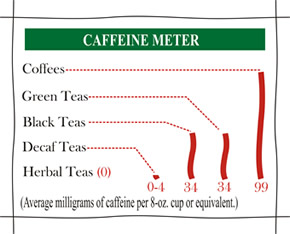Tea refers to both the plant as well as the beverage made from infusing in hot water, the leaves of the tea plant
(Camellia sinensis)
The three main categories are green, black, and oolong and come from the same plant species. They are differentiated by their oxidation levels as a result of the different processing methods. Black teas are the most oxidized, Oolong less and Green teas are not oxidized at all.
When herbs are used in a beverage they are called herbal teas or herbal infusions or Tisane (which in French means herbal drink).They are made from different parts of the herbal plants and blended with other herbs to create a soothing, relaxing beverage. Some common herbs used are Chamomile, Peppermint, Rose-hips, Rooibos etc. However tea connoisseurs prefer to use the term 'Tea' only for real tea
All teas come from the
Camellia sinensis
plant. Tea is primarily grown in Sri Lanka (Ceylon), India, China, Kenya and Japan. The teas from these countries are further classified according to the region they grow in. Ex. Nuwara Eliya, Kandy, Dimbula, Uva in Sri Lanka, Darjeeling, Nilgiri, Assam in India.
The distinctive characteristics of flavour, aroma, and color of Ceylon tea is the outcome of the unique climatic conditions, the varying altitudes and soil setting found in each tea growing region of the country.
Rainfall - The Island enjoy two prolonged rainy seasons; the north-east and south-west monsoons respectively. The rainfall coincides with the customary sunny periods across the tea growing regions.
Temperature – The altitude and the location of the land has a large impact upon the temperature-climate for tea growth. (Example, the upland districts (3,500 – 7,500 above sea level) of Sri Lanka have temperatures of 16°C compared to the lowland (1,500 – 1,800 ft above sea level) temperatures of 27°C.
Withering:
The newly plucked tea leaves are thinly spread on racks on which the leaves are warmed so as to reduce the moisture, thus enabling pliability of the leaves for rolling
Rolling:
The leaves are now twisted and rolled by both hand and machine so as to break up the leaf cells allowing the oils and enzymes to be released.
Oxidation:
Here the leaves are allowed to ferment under humid conditions causing the leaves to turn brown or black in color. The oxidation time is a contributing factor that determines if the teas remain Black, Green or Oolong.
Firing
The leaves are dried evenly whist halting the oxidation process. This process is considered the main determining factor of the tea type to be produced.
The Black tea process goes through all the above stages.
Oolong goes through a similar process with the oxidation period being half that of black tea.
The process for making green tea is the shortest, where after the withering procedure; the leaves are fired to prevent oxidation from taking place.

Caffeine is a stimulant drug found in tea as well as in many other natural substances, especially in coffee. The below chart will provide a estimated guideline of the caffeine content in tea in comparison to other beverages:
Other natural sources of caffeine are chocolate and yerba mat�,
Since it is a stimulant, caffeine increases alertness and quickness of response, and often briefly improves mood.
Tea has remained labor intensive for more reasons than one. Tea is still harvested by hand, so as to have an ‘even pluck’ of the same size so that they can dry uniformly. High grade teas mean harvesting only the “two leaves and bud”, leaving out the more mature and coarse leaves, this hand plucking process enables finesse, which machines cannot offer, thereby resulting in a superior quality tea. The use of manual labor has also helped in providing employment opportunities to the many hundreds of plantation workers
Hedley’s Teas comes from some of the finest tea plantations in the country. It is uniquely different from other teas because it is packed within hours of being processed thus making certain optimum freshness is preserved while the value addition is also done totally in Sri Lanka itself. Thereafter it is sold directly to the retailer who in turn sells it to the end customer. What differs with Multi nationals is that they buy poor quality tea in bulk from various tea producing destinations around the world, add minimum value before letting it pass through a lengthy distribution chain, sometimes taking months before reaching the retailer andthe end customer.
This clearly shows that Hedley’s Tea is 100% Pure Ceylon, packed garden fresh from right where it is grown.